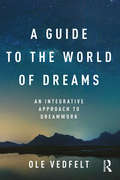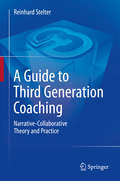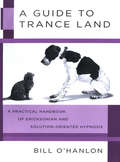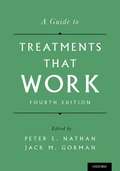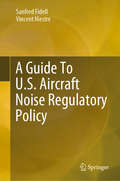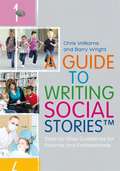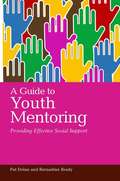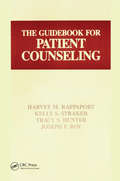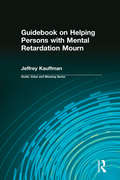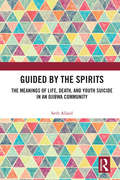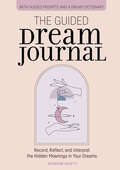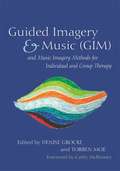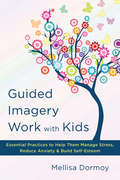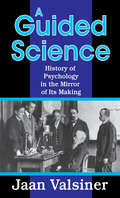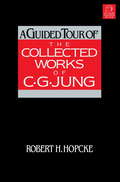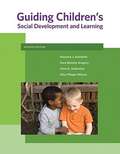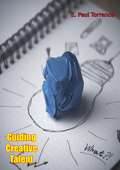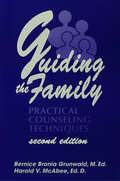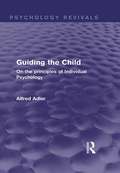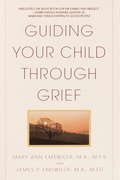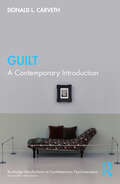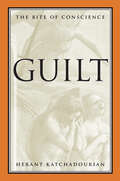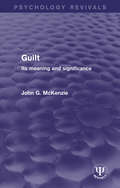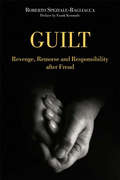- Table View
- List View
A Guide to the World of Dreams: An Integrative Approach to Dreamwork
by Ole VedfeltIn A Guide to the World of Dreams, Ole Vedfelt presents an in-depth look at dreams in psychotherapy, counselling and self-help, and offers an overview of current clinical knowledge and scientific research, including contemporary neuroscience. This book describes essential aspects of Jungian, psychoanalytic, existential, experiential and cognitive approaches to dreams and dreaming, and explores dreams in sleep laboratories, neuroscience and contemporary theories of dream cognition. Vedfelt clearly and effectively describes ten core qualities of dreams, and delineates a resource-oriented step-by-step manual for dreamwork at varying levels of expertise. For each core quality, key learning outcomes are clarified and resource-oriented, creative and motivating exercises for practical dreamwork are spelled out, providing clear and manageable methods. A Guide to the World of Dreams also introduces a new cybernetic theory of dreams as intelligent, unconscious information processing, and integrates contemporary clinical research into this theory. The book even includes a wealth of engaging examples from the author’s lifelong practical experience with all levels and facets of dreamwork. Vedfelt’s seminal work is essential reading for psychotherapists, psychologists, counsellors, and even psychiatrists, and could well be a fundamental textbook for courses at high schools, colleges, universities and even in adult-education classes. The book’s transparent method and real-life examples will inspire individuals all over the world who seek self-help or self-development – any reader will be captivated to discover how knowledge of dreams stimulates creativity in everyday life and even in professional life.
A Guide to Third Generation Coaching: Narrative-Collaborative Theory and Practice
by Reinhard StelterThis book proposes third generation coaching in a form where the coach and the coaches are less concerned with solutions and more concerned with creating space for (self-)reflection through collaborative practices. Offering a revisited and innovative approach to coaching psychology, advantageous for learners and practitioners alike. It marks a new trend in coaching and has a special profile, based on the acknowledgement of changes in society, learning and knowledge production, as well as leadership. The author' s concept of coaching distinguishes itself from the existing models (pop coaching , GROW model, etc) by offering a fresh analysis of our society - a society that is characterised by diversification, identity challenges, abolition of the monopoly of knowledge, lifelong learning, the necessity for self-reflection, etc. These societal changes are the basis for the existence of coaching and its prevalence, but they must also be the foundation for the way we employ coaching.
A Guide to Trance Land: A Practical Handbook of Ericksonian and Solution-Oriented Hypnosis
by Bill O'Hanlon<P> A friendly and brief guide to the essentials of hypnosis. <P> Popular author Bill O’Hanlon offers an inviting and reassuring guide to the essentials of hypnosis, alleviating the newcomer’s anxieties about how to make the most of this clinical tool. This brief book illustrates the benefits of solution-oriented hypnosis, which draws on the work of the pioneering therapist Milton Erickson (with whom O’Hanlon studied) and emphasizes doing what is needed to get results—which, more often than not, means trusting that the client holds within him- or herself answers or knowledge that need only be tapped or released by the therapist. <P> O’Hanlon covers the key aspects of hypnosis, including: using possibility words and phrases; using passive language; and inducing trance. O’Hanlon offers practical tips and friendly encouragement for the novice hypnotherapist—in his characteristic warm, reassuring, and humorous style.
A Guide to Treatments that Work
by Peter E. Nathan Jack M. GormanLike its predecessors, this fourth edition of A Guide to Treatments That Work offers detailed chapters that review the latest research on pharmacological and psychosocial treatments that work for the full range of psychiatric and psychological disorders, written in most instances by clinical psychologists and psychiatrists who have been major contributors to that literature. Similarly, the standards by which the authors were asked to evaluate the methodological rigor of the research on treatments have also remained the same. Each chapter in A Guide to Treatments That Work follows the same general outline: a review of diagnostic cues to the disorder, a discussion of changes in the nomenclatures from DSM-IV to DSM-5, and then a systematic review of research, most of which has been reported within the last few years, that represents the evidence base for the treatments reviewed. In all, 26 of the volume's 28 chapters review the evidence base for 17 major syndromes.
A Guide To U.S. Aircraft Noise Regulatory Policy (Springerbriefs In Applied Sciences And Technology Ser.)
by Sanford Fidell Vincent MestreAviation noise remains the primary hindrance to expansion of airport and airspace capacity in the United States. This book describes the development and practice of U.S. aircraft noise regulation, as well as the practical consequences of regulatory policy. Starting in the pre-jet transport era, the book traces the development of the modern framework for characterizing, standardizing, predicting, disclosing, and mitigating aircraft noise and its effects on airport-vicinity communities. Among other matters, the book treats noise-related consequences of the 1978 deregulation of the airline industry; prediction and mitigation of community reaction to airport noise; land use compatibility planning; recent research and industry trends; and some suggestions for potential improvements to current policy. Initial chapters describe the assumptions underlying aircraft noise regulation, and lay out the chronology of U.S. aircraft noise regulatory practice. Later chapters provide overviews of population-level effects of aviation noise, including health effects, speech and sleep interference, and annoyance. Readers will learn why predictions of the prevalence of aircraft noise-induced annoyance have systematically underestimated adverse community response to aircraft noise, and how such underestimation has complicated approval and funding of airport and airspace improvement projects. They will also learn why attempts at noise-compatible land use planning are seldom fully successful.
A Guide to Writing Social Stories™: Step-by-Step Guidelines for Parents and Professionals
by Barry Wright Chris WilliamsSocial StoriesTM are a widely used and highly effective intervention for supporting children on the autism spectrum, but it can feel overwhelming to follow all the rules put in place to create personalised stories. Developed with the input of parents and professionals, and informed by new Social Stories research, this is a comprehensive, clear, easy step-by-step guide to writing effective personalised Social StoriesTM that give children social information, creating many benefits for them. The book includes many examples of real Social Stories created for children by parents and teachers working together, and handy downloadable checklists that highlight the essential components of a Social Story, helping to ensure that each story you write achieves the best possible results.
A Guide to Youth Mentoring
by Bernadine Brady Pat DolanYouth mentoring can be an effective way of supporting troubled youth, helping them sustain positive mental health, cope with stress, and lead successful lives through adolescence and into adulthood. This book is a comprehensive guide to youth mentoring programmes, illustrating how, if managed well, they can increase the social support available to young people. It outlines the objectives and benefits of mentoring, how it works, and how to mentor successfully. Youth mentoring in community and school settings is covered, as well as mentoring for vulnerable youth. The book illustrates different mentoring models and provides practical strategies for assessing, setting up, and monitoring the mentoring relationship and its outcomes for the young person. The challenges and difficulties associated with mentoring programmes and strategies to overcome them are also addressed. This will be an essential guide for anyone working with young people, including youth workers, social workers, residential care staff, foster carers, community development workers, teachers and community police.
The Guidebook for Patient Counseling
by Tracey S. HunterThis book presents the skills pharmacists need to step out from behind the counter and counsel patients. It is designed to assist practitioners to fully comply with the professional and legal requirements for patient counseling.
Guidebook on Helping Persons with Mental Retardation Mourn (Death, Value and Meaning Series)
by Jeffrey KauffmanThe book contributes to an awareness of the significance of loss in the life experience of persons with mental retardation. Experiencing loss may be a very powerful vulnerability in their mental or psychological life, and dealing with this loss is a basic element in psychological health. There has been an enormous hole in the death and dying literature and in the mental retardation literature on the mourning behavior and needs of persons with mental retardation. This book fills that hole, and lays a foundation for grief support services, establishes standards of practice and care, and is an educational primer about the loss and mourning needs of persons with mental retardation.
Guided by the Spirits: The Meanings of Life, Death, and Youth Suicide in an Ojibwa Community
by Seth AllardGuided by the Spirits is a case study of youth suicide in the Sault Sainte Marie Tribe of Chippewa Indians. Written by a member of the tribal community, this study focuses on qualitative methods, indigenous experience, and collaborative approaches to explore the social and historical significance of youth suicide in an Ojibwa community. Guided by the Spirits combines traditional methods of analysis, extracts of interviews and field notes, and creative ethnographic writing to present the relationships between culture, history, identity, agency, and youth suicide. This book is a must read for lay readers, policy makers, and researchers who seek a window into contemporary Native American life as well as a critical interpretation of youth suicide in indigenous societies.
The Guided Dream Journal: Record, Reflect, and Interpret the Hidden Meanings in Your Dreams
by Katherine OlivettiTap into the wisdom of your dreams and apply their lessons to your life Dreams are an invaluable window into our lives. They can lead to a burst of creativity, shed light on a challenging relationship, or reveal a deeper understanding of a difficult situation. Your dreams often know you better than you know yourself. The Guided Dream Journal will help you learn how to keep a dream journal and work with your dreams. This engaging journal helps you record, explore, and reflect on the themes and symbols that appear in your nightly visions. From helping you remember a long-forgotten memory to solving a seemingly impossible problem, there are so many answers in our dreams that can help us understand our waking life—learn how to interpret them. The Guided Dream Journal includes: Dream variety—Learn about the different types of dreams like lucid, recurring, nightmares, and others, and discover how knowing the storyline, pattern, and genre of your dream can help you determine its deeper meaning. Dream escort—Supportive prompts show you how to pinpoint signs, track insights, and keep a record of your breakthroughs over time. In the know—Use the dream dictionary to better understand and interpret 100 of the most common symbols, settings, colors, animals, and more that show up in dreams. When you want to discover and understand the significance of your dreams, The Guided Dream Journal is your go-to resource.
Guided Imagery: Creative Interventions in Counselling & Psychotherapy
by Eric Hall Diane Young Carol Hall Pamela Stradling`I would recommend reading this enjoyable book in which the authors convey practical, creative and compassionate authenticity throughout. I think it will appeal to experienced counsellors, psychotherapists and arts therapists. It will also be a valuable resource to students' - Therapy Today `Hall et al bring many years of practice and academic experience to their material. The book is accessible in its style and makes extensive use of interesting case histories' - Eisteach (Journal for the Irish Association of Counselling and Psychotherapy) `fascinating scenarios.... a useful book to have - I have really enjoyed reading it' - International Arts Therapies Journal (Online) Guided Imagery is a unique, practical guide to using imagery in one-to-one therapeutic work with clients. Through numerous examples drawn from their own experience, the authors show how the techniques involved can be integrated into everyday practice. The authors describe the different processes of using guided imagery and working from a script and show how drawing can be used to augment imagery work. In addition to planned strategies for using imagery, they also show how images which arise spontaneously during sessions can be harnessed and used to enhance the therapeutic process. The practical strategies and techniques outlined in the book are examined in the context of a variety of theoretical frameworks (the person-centred approach, gestalt, existentialism and psychosynthesis) and research findings. Potential pitfalls and ethical considerations are also explored, making Guided Imagery a useful resource for practitioners and an ideal text for use on counselling and psychotherapy training courses.
Guided Imagery & Music (GIM) and Music Imagery Methods for Individual and Group Therapy
by Marte Lie Noer Mary Regina Reher Line Brink-Jensen Evangelia Papanikolaou Cathy Mckinney Therese Marie West Wai Man Ng Isabelle Frohne-Hagemann Alice Pehk Frances Smith Goldberg Rachael Martin Svein Fuglestad Denise Grocke Anthony Meadows Esperanza Torres Lars Ole Bonde Ellen Thomasen Anthony Hall Carola Maack Carolyn Van Dort Annie Heiderscheit Nicki S. Cohen Ian Robert Leslie Linda Powell Maria Montserrat Gimeno Margareta Warja Louise Dimiceli-Mitran Torben Moe Catharina Messell Gunn Karoline Fugle Ruth Hertrampf Inge Nygaard Pedersen Santiago Vilá Lisa Summer Bolette BeckThis is the first book to systematically describe the range of approaches used in music imagery and Guided Imagery and Music across the lifespan, from young children through to palliative care with older people. Covering a broad spectrum of client populations and settings, international contributors present various adaptations of the Bonny Method of Guided Imagery to accommodate factors such as time restraints, context (including hospitals, schools, and the wider community), client symptomology, and the increasing use of more contemporary music. Each chapter presents a different model and includes background information on the client group, the type of approach, elements of approach (including length of the session, choice of music, verbal interventions during the music, and discussion of the experience), and theoretical orientation and intention. A nomenclature for the range of approaches is also included. This information will be a valued guide for both practitioners and students of Guided Imagery and Music and receptive methods of music therapy.
Guided Imagery Work with Kids: Essential Practices to Help Them Manage Stress, Reduce Anxiety & Build Self-Esteem
by Mellisa DormoyA toolbox of scripts for practicing a popular relaxation technique with child clients. Guided imagery is a relaxation technique that uses sensory visualizations to engage the mind and imagination for healing. It is a simple, versatile therapeutic tool that uses “scripts” to help clients focus and guide their imagination, and has been shown to alleviate a host of common emotional issues in kids, from anxiety and insecurity to stress, anger, and the effects of bullying. Easier to practice than meditation or hypnosis, guided imagery allows kids to quickly focus, integrate their thoughts, emotions, and feelings, and practice self-compassion, all without the need for extraordinary discipline or time investment. This concise book lays out all the essential guidelines for using this helpful healing practice in therapy, counseling, and any type of helping work with children. The opening chapters present the groundwork, explaining what guided imagery is, how it differs from mindfulness and hypnosis, how it works, and how to integrate it into therapy practice. The second half of the book offers dozens of detailed, ready-to-use guided imagery scripts for therapists to follow in their work with children. This rich collection of scripts is organized around the most common issues children present with in therapy, accompanied by helpful notes for working with particular age groups, and illustrated in practice through illuminating case vignettes. Issues addressed include: • Anxiety and tension • Stress management • Low self-esteem • Emotional health • Difficulty showing empathy • Social stress • Low energy and lack of motivation And much more. Readers will learn techniques to treat a range of child problems and encourage inner healing, happiness, and goal achievement. Small in format, therapists can consult this guide any time they want to use a script with a child during the therapy hour. It’s an adaptable tool for novice and experienced therapists alike to achieve maximum benefits in a minimum amount of time, even with no prior knowledge of guided imagery. Guided imagery scripts can be used in conjunction with any therapeutic approach, and are easily adapted to fit particular needs. With the scripts, skills, and essential principles in Guided Imagery Work with Kids, professionals will have everything they need to begin applying this effective method in their work with young clients.
A Guided Science: History of Psychology in the Mirror of Its Making
by Jaan ValsinerThat sciences are guided by explicit and implicit ties to their surrounding social world is not new. Jaan Valsiner fills in the wide background of scholarship on the history of science, the recent focus on social studies of sciences, and the cultural and cognitive analyses of knowledge making. The theoretical scheme that he uses to explain the phenomena of social guidance of science comes from his thinking about processes of development in general--his theory of bounded indeterminacy--and on the relations of human beings with their culturally organized environments. Valsiner examines reasons for the slow and nonlinear progress of ideas in psychology as a science at the border of natural and social sciences. Why is that intellectual progress occurs in different countries at different times? Most responses are self-serving blinders for presenting science as a given rather than understanding it as a deeply human experience. For Valsiner, scientific knowledge is cultural at its core. Major changes have occurred in contemporary sciences--collective authorship, fragmentation of knowledge into small, quickly published (and equally quickly retractable) journal articles, and the counting of numbers of such articles by institutions as if that is a measure of "scientific productivity." Scientists are inherently ambivalent about the benefit of these changes for the actual development of knowledge. There is a gradual "takeover" of the domain of scientific knowledge creation by other social institutions with vested interests in defending and promoting knowledge that serves their social interests. Sciences are entering into a new form of social servitude.
A Guided Tour of the Collected Works of C. G. Jung
by Robert H. HopckeThe writings of C. G. Jung himself are the best place to read about all his main ideas--but where to start, when Jung's Collected Works run to more than eighteen volumes? Robert H. Hopcke's guide to Jung's voluminous writings shows exactly the best place to begin for getting a handle on each of Jung's key concepts and ideas--from archetypal symbols to analytical psychology to UFOs. Each chapter explains one of Jung's principal concerns, then directs the reader where to read about it in depth in the Collected Works. Each chapter includes a list of secondary sources to approach for further study--which the author has updated for this edition to include books published in the ten years since the Guided Tour's first appearance.
Guiding Children's Social Development and Learning (Seventh Edition)
by Marjorie Kostelnik Kara Gregory Anne Soderman Alice WhirenGUIDING CHILDREN'S SOCIAL DEVELOPMENT AND LEARNING, Seventh Edition, focuses on ways professionals can help children develop both positive feelings about themselves and social competence. Readers will find practical, developmentally appropriate strategies for how to work with children and families from many different backgrounds and circumstances, and in a variety of group settings. And, they'll obtain a unified framework for decision-making and professional practice that incorporates sound principles of children's development, relationship enhancement, and behavior management.
Guiding Creative Talent
by E. Paul TorranceAnyone with an interest in the problems of highly creative children will find this volume useful in guiding a wide range of creative talent at all age and educational levels. In preparing this material, I have drawn most heavily upon my own research and that of my colleagues concerning the creative thinking of children, adolescents, and adults. Although my emphasis is upon the problems of highly creative children, I believe you will find these materials useful in guiding a wide range of creative talent at all age and educational levels. I have also attempted to give these research findings and observations meaning from my experience as a teacher, counselor, and principal in a high school and as a college teacher and counselor, roles in which I have met many highly creative individuals. I have also drawn upon my research concerning behavior under emergency and extreme conditions, especially situations involving coercion.
Guiding The Family: Practical Counseling Techniques
by Bernice Bronia Grunwald Harold McAbeeFirst published in 1999. Routledge is an imprint of Taylor & Francis, an informa company.
Guiding the Child: On the principles of Individual Psychology (Psychology Revivals)
by Alfred AdlerFirst published in 1930 this book was written under the leadership and inspiration of Alfred Adler. He and a group of physicians and educators organized 28 child guidance clinics in Vienna, Berlin and Munich in the years prior to publication. Conducted according to the tenets of Individual Psychology, these clinics revealed many new and stimulating problems that they felt were as applicable to conditions in America and England at the time as in the experimental countries. The book was designed as an organized and connected account of the problems, accomplishments and failures encountered in the daily work, reported from actual experience by the experts in charge. Adler edited the volume and assigned each subject to the specialist in that field. The result was designed to be of value to the welfare worker, the physician, and the forward-looking parent of the time. Today it can be read and enjoyed in its historical context.
Guiding Your Child Through Grief
by Mary Ann Emswiler James P. EmswilerGive your child the help and support needed to cope with grief and loss. Guiding Your Child Through Grief, by the founders of the New England Center for Loss & Transition and The Cove, a highly praised program for grieving children, takes away the uncertainty and helpless feelings we commonly feel as we reach out to children who mourn. This caring and compassionate guide offers expert advice during difficult days to help a child grieve the death of a parent or sibling. Based on their experience as counselors--and as parents of grieving children--the authors help readers to understand: The many ways children grieve, often in secret Changes in family dynamics after death--and straightforward, effective ways to ease the transition Ways to communicate with children about death and grief How to cope with the intense sorrow triggered by holidays The signs grief has turned to depression--and where to find help And more insights, information, and advice that can help a child heal
Guilt: A Contemporary Introduction (Routledge Introductions to Contemporary Psychoanalysis)
by Donald L. CarvethThis insightful and innovative book sheds light on the complexity of the concept of guilt, while exploring aspects of guilt that have previously been overlooked in psychoanalytic theory and discourse. Offering original insights on the topic, Donald Carveth looks at Freud's failure to distinguish persecutory guilt from reparative guilt, and the superego from the conscience. The significance of these distinctions for both psychosocial theory and clinical practice is explored throughout the volume. Carveth distinguishes varieties of punitive guilt, such as justified, unjustified, "borrowed" or induced, existential and collective. He expertly describes patterns of self-punishment and self-sabotage, while also addressing the widespread use of persecutory guilt and self-punishment as a defence against and evasion of reparative guilt, contrition, and reparation. Throughout the volume, Carveth critically reviews a range of recent contributions to psychoanalytic literature to support his theories. Part of the Routledge Introductions to Contemporary Psychoanalysis series, this book will be of interest to psychoanalysts, psychotherapists, social scientists, and social philosophers, as well as to those studying ethics and theology.
Guilt: The Bite of Conscience
by Herant Katchadourian<div><p class="description"><i>Guilt: The Bite of Conscience</i> is the first book to study guilt from a wide variety of perspectives including those of psychology, psychiatry, psychoanalysis, evolutionary psychology, anthropology, six major religions (Judaism, Christianity, Islam, Hinduism, Buddhism, Confucianism), four key moral philosophers (Aristotle, Kant, John Stuart Mill, and Nietzsche), and the law. Katchadourian first explores the ways in which guilt functions within individual lives and intimate relationships, looking at behaviors that typically induce guilt in both historical and modern contexts. He then turns to the way the capacity for moral judgments develops within the individual lives and through evolutionary processes, taking up both normal and pathological (whether excessive or inadequate) manifestations of guilt.</p> <p class="description">The second part of the book turns to the socio-cultural aspects of guilt. In what ways does religion deal with guilt? Does it compound it or help individuals to resolve it? How do the major religious traditions differ in their conceptions of guilt? Secular alternatives in dealing with guilt are considered in the light of the key moral philosophies that have exerted the most influence in Western cultures. Finally, Katchadourian addresses the ways in which society attempts to come to terms with guilt as culpability through the legal process.</p> <p class="description">This personal work draws from, and integrates, material from extensive primary and secondary literature. It is a reliable guide to what scholars, investigators and clinicians have to say about the topic. Through the extensive use of literary and personal accounts, this book provides an intimate picture of what it is like to experience this universal emotion. While the book is not intended to be a self-help manual, each chapter addresses the issue of how to deal with guilt from a particular point of view. Written in clear and engaging prose, with a touch of humor, Guilt should appeal to a wide audience.</p></div>
Guilt: Its Meaning and Significance (Psychology Revivals)
by John G. McKenzieIt is acknowledged by most students of human behaviour that the idea of guilt is closely connected with that of man’s freedom and responsibility. It is a theme of law-court and pulpit, a concern of psychoanalysis and probation officers, a growing pre-occupation of the novelist. Our era has even been described as a ‘guilt-consciousness age’. It comes as a surprise, therefore, to discover that there are so few modern books in which the meaning of guilt is thoroughly explored. In the present volume, originally published in 1962, Dr J.G. McKenzie makes an admirable attempt to fill the gap. He begins by describing and analysing the various senses in which the word ‘guilt’ is used and by making a number of important distinctions. There follows a close psychological study of the origin and development of guilty feelings which is illumined by Dr McKenzie’s interpretation of ‘negative’ and ‘positive’ conscience. The author then turns to the legal, ethical and religious concepts of guilt and examines each with care and insight, always raising and facing the deepest issues for both theory and practice. In the concluding section of the book he deals with the question ‘How can the sense of guilt be dissipated?’ Against the backdrop of depth-psychology and theology he offers a penetrating and provocative understanding of divine forgiveness which plumbs the deeps both of man’s sin and of God’s love. Dr McKenzie writes out of a long lifetime of teaching and of clinical work in psychotherapy. The range of his reading and interests is extraordinarily wide. Through all his writing there shines not only his profound concern for people but his lively and indeed infectious conviction that man is still in the making and that his one true Maker is God.
Guilt: Revenge, Remorse and Responsibility After Freud
by Roberto Speziale-BagliaccaGuilt is an original, closely argued examination of the opposition between guilty man and tragic man. Starting from the scientific and speculative writings of Freud and the major pioneers of psychoanalysis to whom we owe the first studies of this complex question, Roberto Speziale-Bagliacca goes on to focus on the debate between Klein and Winnicott in an enlightened attempt to remove blame and the sense of guilt from religion, morality and law. Drawing on an impressive range of sources - literary, historical and philosophical - and illustrated by studies of composers, thinkers and writers as diverse as Mozart and Chuang Tzu, Shakespeare and Woody Allen, Guilt covers a range of topics including the concept of guilt used within the law, and the analyst's contribution to the client's sense of guilt. Previously unavailable in English, this book deserves to be read not only by psychoanalysts, philosophers. scholars and forensic psychiatrists interested in the theory of justice, but also be the ordinary educated reader.
